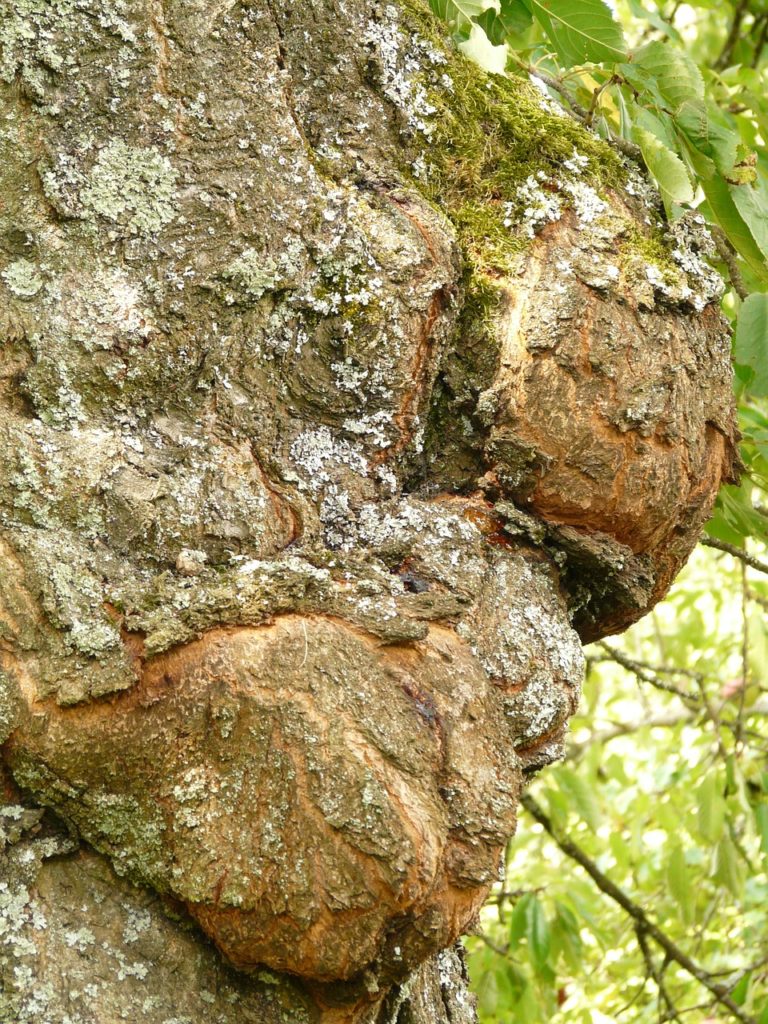Introduction
Canker diseases are symptomatic of an injury associated with a plant that has become infected by a fungal or bacterial pathogen. Canker diseases frequently kill branches, and cause extensive structural damage to trees. Fungal infections rot the cambium, and decay the sapwood as much as three feet above and below the wound. This ability to create cankers, and destroy the cambium distinguishes these pathogens from fungi that affect the heartwood. Cankers are formed by the interaction between the host and the pathogen; they occur when the pathogen develops within the wood as the host simultaneously attempts to contain the growth.
Cytospora canker is one of the most common pathogens. It is caused by the fungus Leucostona kunzei, and can be found on spruce, pine, poplar, and willow. Phomopsis canker infects arbovitae, Douglas-fir, juniper, and Russian olive. It is caused by the fungus Phomopsis vaccinii. Nectria canker appears primarily on honey locust, oak, and maple, with red maple being the most susceptible. It is caused by two fungi, Nectria cinnabarina and Nectria galligena. Hispidus canker, caused by Polyporus hispidus, occurs on a variety of oaks, including willow oak and water oak. It may occasionally infect Nuttal oak, white oak, and hickory as well. Spiculosa canker, caused by the fungus Poria spiculosa, is most common on willow oak, water oak, honey locust, and hickory. Irpex canker is typically relegated to red oaks. It is caused by the fungus Irpex mollis.
Disease Cycle
Canker diseases are most common on stressed, or injured plants. Most cankers are caused by infectious fungi, which invade the plant’s bark tissue. Many environmental stressors provide ample opportunities for canker diseases to invade susceptible plants. These include periods of extreme temperatures, water stress from flooding or drought, sunburn or sunscald injury, damage resulting from hail, high winds, or lightning strikes, nutrient deficiencies, soil compaction, mechanical injuries, pruning wounds, root rot, insect borers, improper planting, and excessive mulching.
Disease pathogens generally enter through branch stubs, or bark wounds. Some colonize the injured bark, and inner tissue, causing canker rots that persist for years. All fungal cankers contain fruiting bodies called perithecia that appear as small, black or red-orange growths embedded in the bark. The spores produced by these fruiting bodies serve as inoculum for new infections, particularly during rainy conditions in spring. When the fruiting bodies mature, they eject the spores, which are disseminated by the wind. Spores that invade the wounds of susceptible hosts may germinate, and start new infections.
Symptoms
Cankers are brownish-red, and vary considerably in size. They typically range from oval to elongate in shape. They often appear as sunken, slightly discolored lesions on localized areas of dead bark. Lesions may also develop on the underlying wood of twigs, branches, and trunks. Cankered bark often splits between the diseased and healthy tissue. The inner bark turns black, sometimes exuding a pungent odor. As the pathogen reaches the sapwood, it disturbs the plant’s vascular system, hampering the transportation of water and nutrients. This often results in significant twig and branch dieback.
On infected branches, new leaves may be stunted. As the infection progresses, leaves transition from pale green to yellow or brown, often curling upwards.
Prevention & Management
- Prune and dispose of any infected twigs or branches. Pruning cuts should be administered at the branch collar. This will enable the wound to effectively callus over. Always remove any lingering branch stubs; these can die back, creating access points for infectious pathogens. Pruning tools should be sterilized between cuts with rubbing alcohol, or a solution comprised of one part household bleach, and nine parts water.
- When planting, consider using hardy plants that are well adapted to the climate of the area. This will help minimize the potential for infection.
- Maintain plant vigor through sound cultural practices.
- Ensure that plants are sufficiently watered.
- Apply a layer of organic mulch around the base of trees and shrubs. Mulching helps to improve soil quality, and moderate soil temperature.
- Prune trees and shrubs periodically to maintain their proper size and shape. Avoid pruning during wet conditions.
- Once a trunk becomes cankered, the tree or shrub may attempt to callus over the wound. Cankered trees should be culled to prevent infections from spreading to healthy trees.


